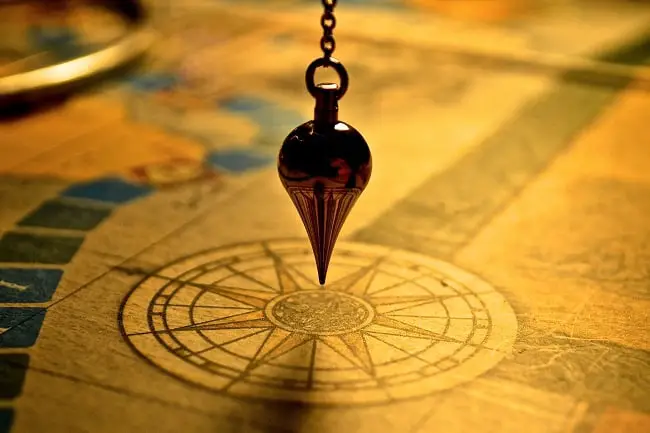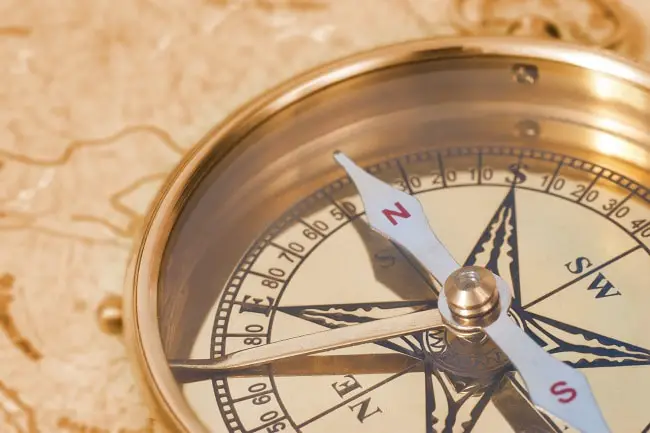Have you ever wondered how the compass works? When was it invented? The first time compasses were invented is a subject of debate, some sources say as far back as ancient China!
In this article, we’re going to go over the history of the magnetic compass, when and why it was used, and even how it was made.
If you’re interested in learning about the history of the compass then read on!
When was the magnetic compass invented?
The first magnetic compass was created in China between the 1st and 2nd century BC during the Han dynasty. Originally it was made out of ore from iron known as lodestone which contains natural magnetic properties.
Lodestone was a material that was widely known to have magnetic properties before the creation of the first compass but there was little use for them.
They have documented in the writings of Plinius the Elder when he discussed a Shepherd known as Magnes found that the iron from his shepherd’s staff and the metal nails in his shoes stuck to the rocks of mountains that contained this material.
Within China, Chinese writer Wang Xu noted that lodestones attracted iron and other writings document a spoon made from the same material always ended up pointing in the same direction when dropped on the ground.
What was the magnetic compass used for?
The magnetic compass worked by having the magnetic material shaped like a needle that could freely move around to match up with the Earth’s magnetic field by always pointing towards the magnetic North.
Due to the compass always pointing north, it is then easy to work out other directions from it.
Originally it was not created for the purpose of navigation and instead was instrumental in early Chinese Geomancy also known as fortune-telling which interpreted lines or geographic alignments.
It was also used in Feng Shui which is a traditional practice that invites positive Chi into the surroundings creating a balanced and energizing environment.
The idea of this is that certain features of the room should line up with different compass directions. Later, it was used in navigation and orienteering.

It was during the Song Dynasty in China that the compass was first used to help navigate. In a book that dates back to 1040, a needle in the shape of a fish was placed in a bowl of water to indicate direction.
Most compasses during this Dynasty had a unique design and the lodestone was shaped like a spoon. The spoon would be put into a bronze round disk which would then make it spin around.
The bronze disk would have directional points on it as well as star constellations and other informational symbols.
When the spinning stopped, the handle of the spoon would be pointing southwards, while the bowl of the spoon always faced north. A nickname for these compasses was ‘South Pointers’ or ‘South Governors’.
In China, the magnetic compass is first used for navigation on sailing journeys in the early 1400s, where it was widely documented that Chinese explorer Zheng He used them on all the ships on his fleet to journey across the planet to locations such as other countries in Asia, eastern Africa, and the Middle East.
The increased popularity of the magnetic compass
While it originated in China, the magnetic compass came to Europe sometime between 1187 and 1202 according to documentation.
Some believe that Europeans developed their own version of the compass, however, most experts have come to the conclusion that it was more likely introduced to them by Muslims who themselves had learned of the compass through the Chinese.
This theory is backed up by the book ‘De Naturis Rerum’ which translates to ‘On the Nature of Things which said that sailors from the East used needles with magnets to help them find their way.
The compass which floated on water (floating compass) was used for astronomy while a dry version was used for sailing.
This changed the way that sea travel worked, as previously it only happened between October and April but now due to the magnetic compass, it could happen any time of the year.
In Europe in the 13th century, improvements were made to the original compass design. The English at the time dominated the seas and had a large navy that needed accurate navigation, so they pioneered improvements to the device.
The needle now was pinned in the middle of a compass bowl that hung on gimbals. A card with all the navigational points painted on it was mounted above the needle, indicating direction clearly.
Gimbals were rings on the side of the bowl which let it move freely, allowing the card to be level and the reading to be accurate.
Also during the 13th century, the compass was used for both astronomy and navigation throughout the Muslim World but there was also an additional use for it.
It became known as the “Kabba Indicator” which helped Muslims to locate which direction Mecca was in, in order to assist prayers.
Ibn al-Shatir, a famous Syrian astronomer combined the ideas of the original compass design with a traditional sundial.
This allowed the device not only to locate Mecca but also helped identify which times to undertake Salat prayers – which helped many across the Muslim world.
The compass also had a vital role in what we now call ‘The Age of Discovery, a time period of exploration where many European nations discovered parts of the world that were previously unknown.
The magnetic compass literally changed the future of the world as it enabled famous explorers to travel to new lands such as the conquistadors from Spain who sailed across the Atlantic Ocean and discovered the Inca and Aztec civilizations and found many natural resources that we rely on today.
The compass also helped navigate the seas and document quicker trade routes for products such as tea, spices, and silk.
The 15th century led to another discovery – the compass of a needle did not point directly to the North Pole but only close to it. Compasses in Europe were found to point slightly towards the East.
To try and rectify this, British navigators used a compass known as conventional meridional compasses which matched up compass needles and true north when ships passed a point in Cornwall, England.
The Magnetic Compass Today
A compass is still a great tool that is used for both navigation and orienteering. It may look more refined and use more modern materials, but it is still the same basic science used by the Chinese thousands of years ago.
Some of these trade routes discovered by early explorers using the magnetic compass are still used today to transport goods around the world – and you can be guaranteed that all the ships still have more modern versions of the compass on board.

Modern compasses are usually mounted on the ship on pedestals that light up the compass face from below – these are known as binnacles.
The binnacles are all specially designed for ships and contain magnetics that is particularly placed to stop any effects that the metal from modern ships would have on the compass, ensuring that it works correctly.
As you can imagine, in modern times it is not just boats and ships that need to know the direction to help them navigate. Planes and helicopters now also need to know which direction they are traveling in.
Binnacles are also used in aircraft for the same reason, but these compasses also include a mechanism known as a gyroscope which quickly corrects the compass when airplanes suddenly change direction or altitude.
Some however argue that we do not need the humble magnetic compass anymore due to the development of satellites and GPS.
GPS units are not widely available in ships, planes, cars, and even our mobile technology which allows us to access satellites that can not only tell us where we are but can identify the direction that we are traveling in and how to get to different locations.
Experts say that there is still a place for traditional magnetic compasses as modern technology can be tampered with, lose signal, or run out of charge from a battery.
They will never work perfectly, unlike a simple magnetic compass. Therefore, it is unlikely that this little but important tool will disappear anytime soon.
Final thoughts
Hopefully, this post has taught you a bit about the history of the magnetic compass.
Along the way, I’ve also managed to clarify some of my own thoughts on the matter. But what do you think?
Leave your thoughts in the comments below and let me know where we might need to revise our story, or if you have any feedback on how to improve it in general.
Thanks for reading.

